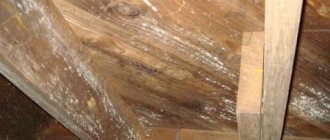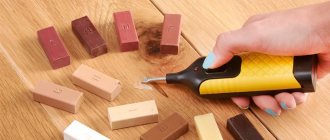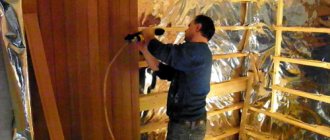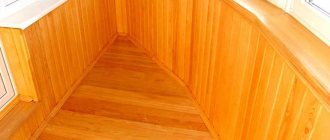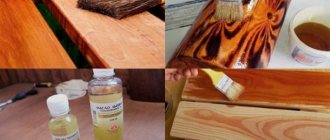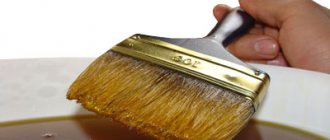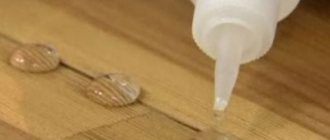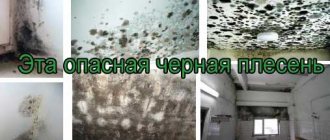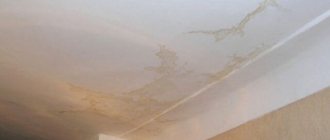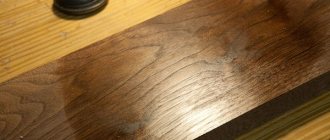Every owner of a wooden house, bathhouse or any other wooden structure asks a similar question. Once ignited, wood burns very well, so the fire can be stopped at one of two stages of fire progression. The first stage is ignition, the second stage is combustion. To fight fire at the first stage, fire retardants of the second group (lighter fire protection) are suitable, and to fight fire at the second stage it is better to use fire retardants of the first group (more serious fire protection).
Fire protection preparations are called fire retardant impregnations. Their action is to penetrate into the wood structure, providing an antiseptic effect and fire protection when the treated wood is exposed to flame.
No. 1. From what and in what cases should wood be protected?
Wood preservatives are aimed against various negative influences, and the choice depends on the conditions under which the material will be used . The main enemies of wood are:
- moisture (fog, rain, high indoor humidity). Wood is characterized by the ability to absorb moisture and swell when its content in the environment is high and, conversely, dry out during dry times. Such fluctuations in volume lead, at a minimum, to cracks, and when constructing a building from wood, the entire structure can be seriously damaged. Therefore, it is necessary to treat wood with means that reduce moisture absorption, but do not affect the ability to “breathe”;
- Mold, mildew, mosses and insects often attack wood when there is high humidity and limited air access. Rotting, the appearance of moss, the spread of bark beetles, termites, woodworms and other pests affect not only the appearance of the wood, but also its structure;
- fire . Wood is flammable and burns quickly. There are no products yet that provide 100% protection from fire, but there are substances that affect the structure and increase the non-flammability time;
- UV rays, when exposed for long periods of time and intensity, destroy wood, most affecting lignin, the substance that provides rigidity and hardness.
To increase resistance to all these factors, there are a number of specific means - a complex composition does not yet exist, so if wood needs to be protected, for example, from both moisture and fire, the use of several means will be required.
Fire expert's opinion - how to protect a tree from open fire?
The construction of wooden buildings is growing rapidly due to the unique characteristics of wood. But when building a log house, you need to remember about fire safety, because... wooden material is not able to withstand fire. These safety measures concern not only the presence of fire shields, sand, a fire extinguisher that can stop the fire, but also the treatment of all wooden walls and rafters with fire retardant compounds.
No. 2. General principles for choosing wood preservatives
Regardless of what factor the product is aimed at combating, when choosing, pay attention to the following nuances:
- coating service life . The protective agent can last on the surface for about 2-5 years, and if the manufacturer indicates such numbers on the packaging, then he is probably not lying, but durability of 20-40 years should be treated with caution. Most likely, this is just a marketing ploy, and in small letters in an inconspicuous place on the packaging it will be indicated that such a period of protection is possible only when the product is applied by deep impregnation (this is an industrial technique) or if the composition is washed out, which is impossible to achieve;
- composition consumption. Often, cheap products are unpleasantly surprised by the increased consumption of the composition, which is why all their efficiency is reduced to nothing, so when purchasing, you should pay attention to the figures indicated by the manufacturers. The average consumption of bioprotective agents is 200-250 g/m2, but not 500-600 g/m2, which can be seen on the packaging of some inexpensive formulations. Such high consumption is typical only for fire retardant compounds;
- manufacturer's name . High-quality protective equipment can only be produced on high-tech production lines, which large enterprises with a well-known name can afford. For the sake of your peace of mind and guaranteed results, it is better to overpay a little;
- versatility _ Some companies offer complex products that supposedly protect wood from both fire and rot, and the active ingredients, according to manufacturers, only enhance each other’s effect. Experts say that even substances that may be in the same solution sometimes not only do not enhance each other’s effect, but also reduce protection;
- composition and certificate of conformity. The composition of protective agents includes a lot of substances, each of which has its own role, but attention should be paid to the base of the drug - these can be organic and inorganic substances. Inorganic substances, which include sodium and potassium bichromates, chloride, chromium and fluorine-containing compounds, copper and zinc salts, negatively affect humans, metals and the color of wood, and are therefore prohibited for use in Europe. Organic-based products are more effective and avoid negative health effects. Any protective product must have a certificate of conformity confirming its safety.
Low-cost fire protection measures
- Install a fire protection RCD - a protective shutdown device. The electrical panel of a private house must be equipped with an RCD; it is not that expensive. Even better, install a differential circuit breaker, it will also protect you from short circuits and overloads in the system. An RCD must also be installed in the house - after the meter, to protect the network.
- Install smoke detectors and fire alarms. Normally functioning sensors reduce the risk of fire by more than 50%. Installation is necessary in every room, on every flight of stairs, in the boiler room, bathhouse, garage...
- Do not use flammable insulation materials during construction.
- Do not forget to carry out regular maintenance of heating equipment - at least once every six months. If you used materials not in accordance with SNIP, then check and replace equipment elements - pipes and so on - even more often. From personal experience: our neighbors installed an asbestos pipe in their boiler room instead of a more reliable one, because they wanted to save money. The result is a completely burned house. The tragic mistake of not wanting to carry out maintenance and repairs in a timely manner.
- Install large address signs, clearly visible from the road, on the walls of the house: the higher, the better.
- Install large, highly visible address signs at the entrance to your home. Use non-flammable materials.
- Install metal screens in all attics, around the perimeter of the foundation, and in all places where fallen leaves and pine needles may accumulate.
- Install fire extinguishers in the house, always in the kitchen and garage, at least one per floor.
- Install a metal shield between the wall of the house and the adjacent wooden fence.
- Replace evergreen shrubs with less flammable plants near your home.
- Clear dry branches and trim coniferous plants around the house.
- Buy a weather warning radio and use it to know about an emergency in time.
- Replace vinyl gutters and downspouts with similar ones made from fire-resistant materials.
- Install spark arrestors or heavy metal screens on all fireplaces and chimneys.
No. 3. Wood protection methods
To ensure the longest possible preservation of wood, a set of measures is used. These are constructive solutions consisting in correct placement and layout, as well as regular monitoring of the condition of the wood and the means themselves for protecting the wood.
Protective agents can be applied in the following basic ways:
- antiseptic – surface treatment of wood. In private construction it can be carried out using a brush or sprayers, and in industrial conditions it is carried out by soaking in protective compounds;
- canning carried out only in industrial conditions. For this purpose, autoclave impregnation can be used, when processing is carried out under high pressure, impregnation in hot-cold baths, or autoclave-diffusion treatment.
Fire retardant compounds from Prosept
Prosept is also a popular Russian company specializing in the production of compositions for coloring wood and providing it with comprehensive protection. Their line of products includes the following high-quality flame retardants:
1) Ognebio Prof 1. This product provides the material with a high, 1st group of fire resistance. It also prevents damage to wood by biological agents. The composition does not contain toxic components, so it can be used to treat wooden materials indoors and outdoors. Comprehensive protection will be provided to the wood for 7 years.
2) Ognebio Prof. This composition provides the treated wooden material with fire resistance group 2 and prevents biological effects on it. Can be used for application to wood indoors and outdoors, but only under a canopy so that the material does not have contact with precipitation, soil, or moisture. This impregnation does not have a negative effect on the structure of the wood, its properties and appearance.
To ensure fire protection for a wooden house, it is better to trust the domestic compositions Neomid or Prosept. Their high quality, low cost and long service life will please many log house owners.
No. 4. Products for protecting wood from moisture
An increased level of humidity is the main enemy of wood, as it not only impairs performance, but also causes the appearance of mold and mildew. Treatment aimed at protecting against moisture begins with wood harvesting, and proper drying is of great importance. Even well-dried material will begin to absorb moisture over time, but in this parameter, different types of wood differ greatly. Larch, ash, pine, oak are more resistant to moisture, spruce, fir and beech are moderately resistant, and maple, birch and hornbeam are the most vulnerable. A number of tropical trees (kumaru, cousia, ipe, sisal) are practically not afraid of moisture and require only minimal protection.
The most important indicator of wood is intracellular moisture . For construction, you can use a material with a moisture content of 5-20%, and wood with a moisture content of 9-15% is suitable for truss structures and interior decoration, and 12-18% for exterior cladding.
To reduce the ability of wood to absorb moisture from the environment, i.e. to reduce its hygroscopicity, use varnishes, oil impregnations and pastes , which are divided into two groups:
- compositions that form a film on the surface are not durable enough, so the treatment will have to be repeated quite often;
- penetrating compounds are more durable and are able to penetrate the pores of wood; they are used to treat fences, window frames, house walls, and garden furniture.
As a rule, water repellents do not change the color of wood, and their effect is that drops of water simply roll off the surface without penetrating into the structure. A number of such products also have a frost-resistant effect.
Free fire prevention measures
- Perform a fire safety assessment of your home, at least visually.
- Keep firewood a safe distance from your home.
- Regularly clear the roof and gutters of leaves and pine needles.
- Make sure the house address sign is clearly visible from the road.
- Attach a long hose to the faucet in the yard and run it to the house.
- Trim all tree branches that overhang the roof of the house.
- Trim all tree branches that are closer than half a meter to chimneys.
- Remove trees along your home's driveway.
- Trim tree branches that overhang your driveway.
- Surround the house with a green lawn with a radius of at least 10 meters, if space allows.
- If new home construction is ongoing in your area, speak with the developer and local authority to ensure construction is carried out to fire safety standards.
- Develop and discuss a fire escape plan with your family. Conduct exercises, including with the participation of pets.
- Check your fire extinguishers. Are they charged? Are they easily accessible? Does everyone in the family know how to use them?
- Remove dead wood and flammable vegetation near your home.
- Remove any evergreen shrubs growing near your home, especially if you live in a wildfire risk area. They burn just fine.
- Get home insurance (it's not as expensive per year as you think) or review your home insurance to make sure it will adequately cover damage in the event of a fire. Consult with construction companies to find out the cost of rebuilding and renovating homes in your area. The presence of an insurance policy for property did not leave any cautious family homeless who managed to take care of property protection in time.
- Talk to your children about the dangers of playing with fire.
- If you burn garbage in a designated barrel, stop doing it.
- Collect fallen leaves into compost piles rather than burning them.
- Do not burn the grass on your property, this can have serious consequences.
- Always keep a shovel and a garden hose connected to a water faucet handy when burning anything in your yard.
- Never light a fire in your yard if the wind is blowing toward your house or your neighbor's house.
- Do not forget to check the functionality of smoke detectors at least once a year, and check the expiration date of fire extinguishers.
- Unplug ALL electrical appliances from sockets if you need to leave and there is no one in the house, or before going to bed. Seriously, check the outlets before you go out, it's really easy and quick. It is also necessary to replace cracked or damaged wires.d
- We don’t think it’s worth reminding us of the consequences of smoking in bed, uncontrolled burning of candles, especially under a wooden roof, and how often Christmas trees light up when a garland of lights is shorted out.
- Carefully read the rules for operating gas and heating equipment, stoves, and fireplaces. Using a tape measure, measure whether your fireplace or chimney is installed at the correct distance. Do not look at the fact that the installation company is experienced and professional. Fire safety violations are found everywhere.
- No curtains, textiles, or carpets should be very close to heating appliances or fireplaces; keep a safe distance.
No. 5. Products for protecting wood from rot, mold and insects
Constant high humidity, temperature fluctuations and intense exposure to sunlight make wood vulnerable to microorganisms and insects. To prevent the appearance of mold, antiseptics are used - products that prevent, but do not kill, bacteria. Already during the harvesting of wood, it is coated with antiseptics; re-treatment is carried out after installation and cleaning of the wood. Antiseptics are produced in the form of liquids and pastes; they also reliably protect against insect damage. There are primer-type antiseptics that are used under varnish and painting, but their penetration and service life are short. Antiseptics can be tinted, and experts say that in this way it is much easier to achieve uniform coloring of walls than when using tinted varnish.
If the wood already has traces of rot, then before using an antiseptic, it is necessary to treat it with fungicides - substances that kill fungal and mold spores. The basis for fungicidal solutions can be:
- water . These are environmentally friendly and inexpensive compositions, the disadvantage of which is that they are gradually washed out with water, and therefore are suitable only for internal processing of wood, which does not interact with moisture and soil;
- White Spirit. Such preparations are more resistant to external influences, are poorly washed out with water, since they penetrate deep into the wood, but are not entirely environmentally friendly, and have a pungent odor, which significantly complicates processing.
If traces of insect exposure are found on the wood, you should treat it with insecticidal impregnations , which are available:
- water based. They are used mainly for annual protection of wood during transportation and storage;
- alkyd-based are more stable products that are suitable not only as therapeutic drugs, but also as prevention.
Regular monitoring of the condition of the wood for the smell of rot, the presence of thin white or bluish and brownish films will prevent rotting in time.
Sometimes you may need products to bleach wood and remove bluish, greenish and black stains. Such substances are applied with a brush to the damaged areas, and after a few hours the original color returns.
When purchasing antiseptic compounds, please note that different breeds absorb compounds with different intensities . Thus, birch and beech have high absorbency, cedar, larch, oak, linden, hornbeam - average, and spruce and fir - low. In addition, completely different compositions are used for different purposes. If during transportation the wood only needs preventive treatment, then when constructing the rafter system it is necessary to use hard-to-wash products, which often paint the wood in brownish and grayish shades, reducing its decorative qualities, so such products are not suitable for facades.
Types of impregnation
The following types of impregnations are distinguished: organic-soluble and water-soluble.
Organosoluble impregnations are mixtures that are able to penetrate deep layers of wood, which provides maximum fire protection for structures. But they contain highly flammable solvents.
Therefore, treatment with organosoluble compounds is carried out mainly at production facilities. In addition, they negatively affect human health. Due to these factors, their use in practice is quite rare.
Water-soluble impregnations are the most optimal option for wood processing. But they are effective where wooden structures are not exposed to moisture for a long time. Mainly used for residential complexes and outbuildings.
In turn, water-soluble impregnations are classified into: easily washable mixtures, washable mixtures for fire protection of wood, non-washable mixtures, difficult to wash out mixtures for fire protection of wooden structures.
Advantages and disadvantages of water impregnations:
| Advantages | Flaws |
| dry quickly | penetrate only a small thickness of the wooden product |
| have no smell | protect only the surface layer |
| low cost | high mixture consumption |
| ease of application | low efficiency |
| availability of funds | re-processing required |
| do not pose a threat to human health | not applicable to wooden buildings that are constantly in contact with water |
Most often, easily washable and washable compounds are used to protect interior structures from fire.
No. 6. Means for protecting wood from fire
When exposed to fire, wood will sooner or later ignite, however, large logs resist fire much longer than boards, since a charred layer forms on their surface, which slowly smolders. Any chips or cracks increase vulnerability to fire. To protect wood from fire, fire retardants are used , which can delay the ignition and spread of fire.
Fire retardants are available in the following forms:
- liquid compositions : varnishes, impregnations, enamels and paints;
- solid compositions : backfills and coatings.
Previously, fire retardants were widely produced in solid form; today the market offers mainly ready-made liquid solutions or concentrates. This form of release allows you to use the product more effectively and at the same time increase safety, because when working with powders, poisonous dust inevitably enters the body, and additional equipment is required, which complicates the processing process.
Fire retardants according to the principle of action are divided into:
- active ones are mainly impregnations that contain salts of phosphoric and boric acid. Under the influence of high temperatures they melt, forming a protective layer that prevents the spread of fire;
- passive, which include fire retardant coatings that create a thin heat-reflecting layer on the surface of the wood. When exposed to high temperatures, it swells, forming a screen of non-flammable foam, which slows down the spread of flame and charring of the wood.
The highest quality protection will be applied in an industrial environment, but you can also carry out similar treatment yourself using a brush, roller or aerosol. It is not recommended to process wood with a moisture content of more than 15%. For well-dried wood, compositions based on organic polymers are suitable, and for non-wood with a moisture content of 10-15%, it is better to use water-soluble fire retardants to guarantee. Small wooden pieces can be dipped into the solution and left there for a period of 30 minutes to 24 hours.
Based on their effectiveness, all fire retardants are divided into groups:
- G1 - means, thanks to the treatment of which wood, after two minutes of exposure to a gas burner flame, loses up to 9% of its mass;
- G2 – products with weight loss up to 25%;
- G3 – products that do not provide adequate protection for the tree.
For the treatment of stairs and load-bearing structures, protective agents of class G1 are chosen; in all other cases, fire retardants of class G2 are suitable. If the manufacturer does not indicate the effectiveness at all, then it is better to refuse to purchase such a product.
Compositions and properties
The fire-resistant composition of the impregnation includes special substances. These are nitric acid, sulfuric acid and ammonium salts.
When the surface is exposed to fire, the impregnation components begin a chemical interaction, resulting in the formation of a layer of non-flammable foam coke. This protects wooden buildings, and also releases gases in the process that prevent combustion.
Among organosoluble fire-fighting agents, mixtures containing phosphorus and halogen atoms have become popular.
Of the water-soluble refractory impregnations, mixtures are often used that contain phosphate acid salts - monoammonium, phosphate, diammonium phosphate and others. These substances have been used for a very long time as a fire retardant, both in pure form and as part of other salts.
Typically, diammonium phosphate is combined with ammonium sulfate. When this mixture is heated, ammonia (a non-flammable gas) evaporates and phosphorus oxides are formed, which cover the wood with a fire-retardant film. A mixture of ammonium sulfate and sodium phosphate or a mixture of borax and boric acid are also good fire retardants.
Fire retardant impregnation does not paint wooden structures and does not replace their physical properties and wood structure. In case of fire, deformation can only result in charring of the wood surface.
Of course, fire retardant impregnation for wood will not save you from arson where flammable and combustible solutions will be used.
However, fires often flare up from a small fireplace, which, if fed with flammable substances, begins to operate in full force. Then, wood impregnated with fire retardants will not be able to withstand.
No. 8. Sequence of application of protective agents
To ensure maximum safety of the wood, it is treated with protective agents in the following sequence:
- antiseptics at the stage of procurement and transportation, as well as after the construction of the structure, furniture, organization of finishing;
- treatment with fire retardants if necessary;
- treatment with moisture-repellent impregnations, which will also prevent the leaching of fire retardant and antiseptic;
- applying paints and varnishes with ultraviolet protection;
- sealing joints and seams using acrylic sealant is an important process that prevents moisture from penetrating into the wood.
High cost measures
- Replace the roof with fire-resistant materials, such as Class A tiles.
- Install a protective irrigation system on your roof.
- Install an independent water supply for the sprinkler system, powered by a non-electric pump capable of operating 24 hours unattended.
- Replace wood or vinyl siding with non-combustible siding.
- Replace single-glazed windows and plastic roof windows with reinforced double-glazed windows.
- Sheath cornices, fascias and soffits with aluminum or steel to prevent sparks from entering these areas.
- Reinforce ditches and bridges to support the weight of the fire truck.
- Install gas cylinders near the house, but under no circumstances inside it, and under them install a base of non-flammable material, for example, gravel, with a diameter of at least 3 meters. Use cylinders with a reducer connection on a threaded connection.
- Install electrical wiring underground, but don't just bury the cable so that no one can get to it, but shallowly + protect it from groundwater and getting wet with a waterproof pipe. Take care to prevent mechanical damage from above.
- Correct your driveway by eliminating sharp turns and filling in potholes that could impede the passage of a fire truck.
A fire can easily destroy your life, even if you are lucky enough to save your life. The best protection against fire is careful organization of fire safety measures. Safety for you and your home!
Salt and non-salt water-soluble impregnations
In most cases, fire retardant compounds are used to treat wooden structures that are not exposed to moisture for a long time. Water-soluble impregnations come in salt and non-salt varieties.
Salts have been known for a long time. And these days they are often used due to their low cost. They contain mineral salts of acids such as:
- boric;
- phosphorus;
- coal.
Salt formulations have many disadvantages, these are:
- weak adhesion;
- short period of operation;
- low level of protection;
- significant expense;
- inability to subsequently process with paints and varnishes.
It must be borne in mind that this type of impregnation with water is quite easy to wash off, which reduces the scope of application. It is prohibited to use them in any premises where there is high humidity: saunas, steam rooms. The scope of use of such impregnation is moisture-proof wood located indoors.
Water-soluble non-salt products have significantly more advantages. One of them is the ability to impregnate wood in such a way that it binds to the fibers at a chemical level. This property helps to gain a foothold in it for a long time.
Other advantages include:
- excellent level of protection;
- absolute safety in relation to human health;
- possibility of varnishing and painting treated wood.
Non-salt impregnations cannot spoil the appearance of wood.
All chemical means of protecting wooden structures from fire contain fire retardants. These include substances or mixtures that block the ignition of the treated surface. When wood is exposed to flame, they begin to act in a certain way. The first thing that happens is swelling, and then the foam surface does not allow direct contact of the fire with the wood. At the same time, gas is released, which additionally creates a protective cloud.
The components of the mixture begin to decompose. They release gases that can reduce combustion. And the elements contained in the composition also melt. This leads to the formation of a film on the wooden surface, which reduces the access of oxygen.
